Unit 5 What were you doing when the rainstorm came? Section A (1a~2d) 课件 (37张PPT,内嵌音频)2023-2024学年人教版
文档属性
| 名称 | Unit 5 What were you doing when the rainstorm came? Section A (1a~2d) 课件 (37张PPT,内嵌音频)2023-2024学年人教版 |  | |
| 格式 | pptx | ||
| 文件大小 | 28.4MB | ||
| 资源类型 | 教案 | ||
| 版本资源 | 人教新目标(Go for it)版 | ||
| 科目 | 英语 | ||
| 更新时间 | 2024-01-01 21:41:17 | ||
图片预览


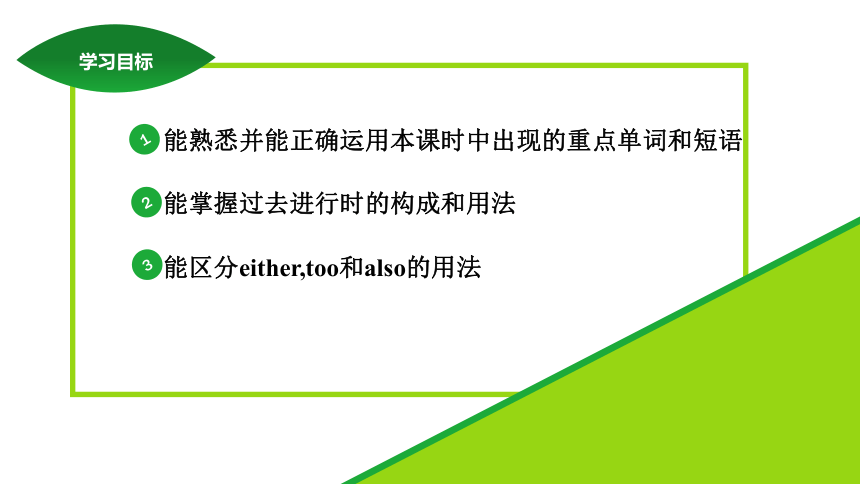
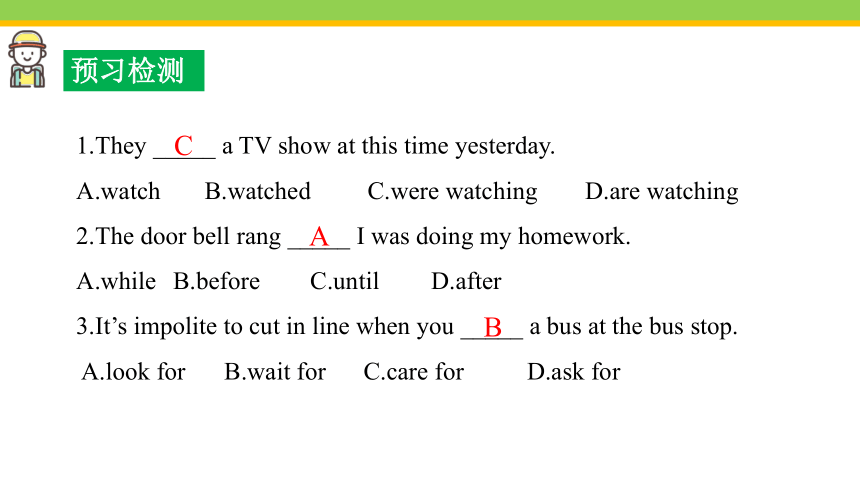


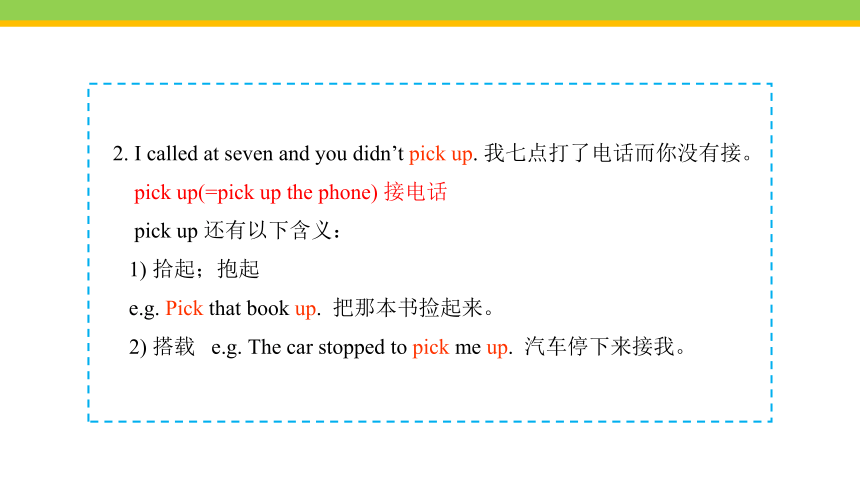
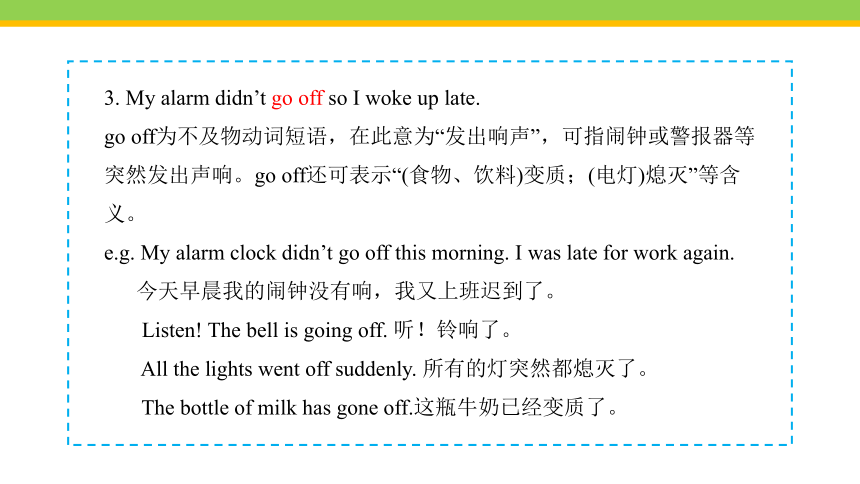
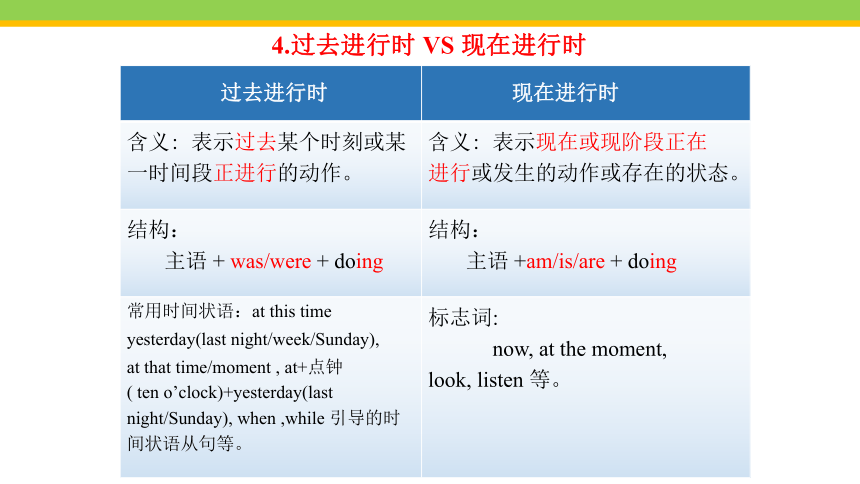
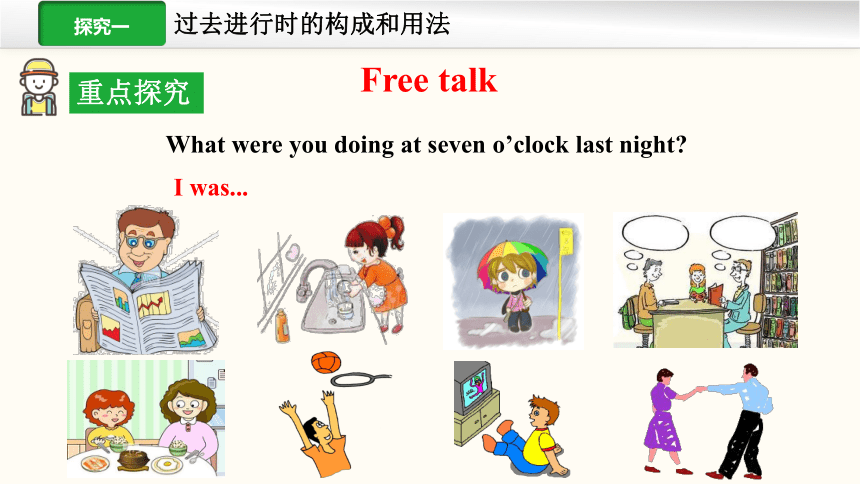
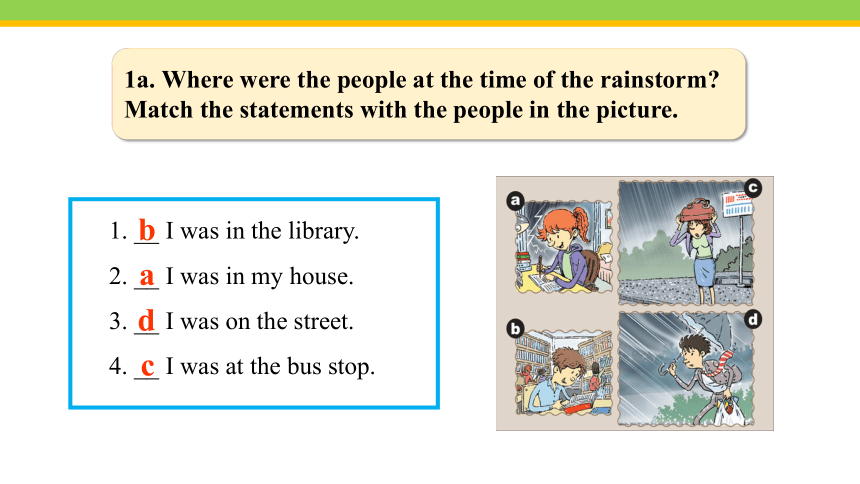

文档简介
(共37张PPT)
Unit 5
What were you doing when the rainstorm came
Section A (1a~2d)
新课导入
Let's watch a video
What was the weather like in the video
It rained heavily.
It was a heavy rainstorm.
rainstorm 暴风雨
2
能掌握过去进行时的构成和用法
1
能熟悉并能正确运用本课时中出现的重点单词和短语
3
能区分either,too和also的用法
预习检测
1.They _____ a TV show at this time yesterday.
A.watch B.watched C.were watching D.are watching
2.The door bell rang _____ I was doing my homework.
A.while B.before C.until D.after
3.It’s impolite to cut in line when you _____ a bus at the bus stop.
A.look for B.wait for C.care for D.ask for
C
B
A
4.—It rained _____ last night.Is everyone in our class today
—Yes, and none of us was late for school this morning.
A.heavy B.heavily C.big D.small
5.I bought _____ alarm clock last week.
A.a B.an C.the D./
B
B
知识梳理
Language points
1. I was waiting for the bus when it began to rain heavily.
begin v. (began) 开始
e.g. I’ll begin whenever you’re ready.你什么时候准备好我就开始。
常用的句型:begin to do与begin doing
一般来说,begin to do和begin doing可以互换,但在以下三种情况下,用to do。
(1)主语不是指人,而是it等。
e.g. It began to rain.
(2)begin后接表示心理活动的词。e.g. begin to know, 还有believe, wonder, think等词。
(3)begin本身是ing形式,为避免重复后接to do。 e.g. beginning to do
2. I called at seven and you didn’t pick up. 我七点打了电话而你没有接。
pick up(=pick up the phone) 接电话
pick up 还有以下含义:
1) 拾起;抱起
e.g. Pick that book up. 把那本书捡起来。
2) 搭载 e.g. The car stopped to pick me up. 汽车停下来接我。
3. My alarm didn’t go off so I woke up late.
go off为不及物动词短语,在此意为“发出响声”,可指闹钟或警报器等突然发出声响。go off还可表示“(食物、饮料)变质;(电灯)熄灭”等含义。
e.g. My alarm clock didn’t go off this morning. I was late for work again.
今天早晨我的闹钟没有响,我又上班迟到了。
Listen! The bell is going off. 听!铃响了。
All the lights went off suddenly. 所有的灯突然都熄灭了。
The bottle of milk has gone off.这瓶牛奶已经变质了。
4.过去进行时 VS 现在进行时
含义: 表示过去某个时刻或某一时间段正进行的动作。 含义: 表示现在或现阶段正在
进行或发生的动作或存在的状态。
结构: 主语 + was/were + doing 结构:
主语 +am/is/are + doing
常用时间状语:at this time yesterday(last night/week/Sunday), at that time/moment , at+点钟 ( ten o’clock)+yesterday(last night/Sunday), when ,while 引导的时间状语从句等。 标志词:
now, at the moment,
look, listen 等。
过去进行时
现在进行时
重点探究
过去进行时的构成和用法
Free talk
What were you doing at seven o’clock last night
I was...
1a. Where were the people at the time of the rainstorm Match the statements with the people in the picture.
1. __ I was in the library.
2. __ I was in my house.
3. __ I was on the street.
4. __ I was at the bus stop.
b
d
c
a
a. doing my homework / studying
b. playing basketball / reading
c. going to work / waiting for the bus
d. walking home / shopping
1b. Listen to the TV report and circle the correct responses.
Pair work
同学们两人一组,看图并仿照下面的对话编新对话。
What was the girl doing at the time of the rainstorm
She was at home doing her homework.
小组展示
1 组
2 组
3 组
4 组
小组内调查:昨晚七点,小组的成员分别在做什么,并将信息填入下面的表格。
Name What were you doing at 7:00 last night
根据调查结果,写一篇总结报告。
At seven o’clock last night, I was...He was...
活动小结
互动检测见DCF课件
过去某一时刻正在发生的动作或持续的状态
was/were
通过以上活动,我们学习了过去进行时的构成及用法,过去进行时表示1._______________________________________;其结构:2.____________+动词的现在分词形式。
when和while的区别及用法
Group work
What can you see in each picture
Can you describe them
2a. Listen and number the pictures 1-5.
1
2
3
4
5
2b. Listen again. Fill in the blanks in the sentences in 2a.
My alarm didn’t go off so I _______ up late.
woke
I _____ to the bus stop but I still missed the bus.
ran
I ____ so busy _______
for the umbrella that I didn’t see a car coming.
was
looking
I ____________ for the bus when it began to rain heavily.
was waiting
I took a hot shower and ____ some warm food.
ate
Role play
根据教材上2a中的信息,两人一组分角色表演这个男孩和电视台记者之间的对话。
小组展示
1 组
2 组
3 组
4 组
阅读教材上2d中的对话,注意对话中哪些句子的时态是过去进行时。
Mary: What were you doing last night, Linda I called at seven and
you didn’t pick up.
Linda: Oh, I was in the kitchen helping my mom.
Mary: I see. I called again at eight and you didn’t answer then either.
Linda: What was I doing at eight Oh, I know. When you called, I was taking a shower.
Mary: But then I called again at nine.
Linda: Oh, I was sleeping at that time.
Mary: So early That’s strange.
Linda: Yeah, I was tired. Why did you call so many times
Mary: I needed help with my homework. So while you were sleeping, I called Jenny and she helped me.
再次阅读2d的对话,回答下列问题。
(1)What was Linda doing at eight last night
(2)Why did Mary call Linda last night
She was taking a shower.
She needed help with her homework.
Pair work
两人一组,分角色演练2d中的对话,然后邀请几组同学表演对话。
小组展示
1 组
2 组
3 组
4 组
when和while的用法
1. when,while都有“当……时候”的意思。
when既可表示某一时间点,也可以表示某一段时间。在when引导的时间状语从句中,其谓语动词可以是延续性的,也可以是非延续性的,可与主句中的谓语动词同时发生,也可在其后发生。
例如:
(1)I was just reading a book when she came into my room.
(2)Were you writing when the teacher came in
2. while只能表示某一段时间,不能表示某一时间点。
在while引导的时间状语从句中,其谓语动词只能是延续性的,而且也只能与主句中的谓语动词同时发生或存在。
例如:
1.While Jim was mending his bike,Lin Tao came to see him.
2.You can’t do your homework while you’re watching TV.
3. 另外,when和while的区别还在于:
while引导的时间状语从句多用进行时态,而when引导的时间状语从句多用一般过去时态。
例如:
1. While they were talking ,the bell rang.
2. I was doing my homework when my mother came back home yesterday evening.
活动小结
互动检测见DCF课件
通过以上活动,我们学习了when和while的区别及用法。when和while作连词,意为 1.“ ”,都可以引导时间状语从句。但when引导的时间状语从句多用2.____________时态,while引导的时间状语从句多用3. 时态。
1.when表示“当……的时候”。从句中既可用4. ,也可用5. __ ,这些动词既可以表示动作,又可表示状态。
2.while表示“在……的时候;在……期间;一边……一边……”。while从句中的动词必
须是表示动作或状态的6. 。它强调主句的动作与从句的动作同时发生或主句的动作发生在从句的动作过程中。
当……的时候
一般过去
过去进行
延续性动词
非延续性动词
延续性动词
区分either,too和also的用法
Do you know the meaning of the following sentences
(1)You don’t like apples.I don’t like them, either.
(2)You know the answer.I know it, too.
(3)His father is also a football fan.
(4)The girl can sing, and she can also play the piano..
Group work
(1)You don’t like apples.I don’t like them, either.
(2)You know the answer.I know it, too.
(3)His father is also a football fan.
(4)The girl can sing, and she can also play the piano..
你不喜欢苹果。我也不喜欢。
你知道答案。我也知道。
他父亲也是个足球迷。
这个女孩会唱歌,还会弹钢琴。
对比这几个句子,分组讨论并区分either,too和also的用法,讨论结束后每个小组选取一位代表发言。
小组展示
1 组
2 组
3 组
4 组
either,too和also的区别及用法
1. either 作副词,意为“也(不)”, 通常用于否定句句末,可用逗号隔开。例如:
You don’t like apples.I don’t like them, either.
2. too 作副词,意为“也;又;而且”,多用于肯定句中,通常置于句末,可用逗号隔开。例如:
You know the answer.I know it, too.
3. also 作副词,表示“也;而且”时,较为正式,多用于肯定句中。通常置于系动词、情态动词、助动词之后或行为动词之前。例如:
His father is also a football fan.
用too, also或either填空。
1.My mother likes dancing and she ______ likes singing.
2.My mother likes dancing.She likes singing, ______ .
3.My mother doesn’t like dancing.She doesn’t like singing, ______.
also
too
either
活动小结
互动检测见DCF课件
通过以上活动,我们学习了either,too和also的区别及用法。
1.either 作副词,意为“也(不)”, 通常用于____________,可用逗号隔开。
2.too 作副词,意为“也;又;而且”,多用于________,通常置于_____ ,可用逗号隔开。
3.also 作副词,表示“也;而且”时,较为正式,多用于________。通常置于系动词、情态动词、助动词_______或行为动词_______。
否定句句末
肯定句
句末
肯定句
之后
之前
1. We _____________ our clothes at six yesterday evening.
2. While Ann __________ with her deskmate, the teacher came in.
3. What ________ he ________ at five o’clock yesterday afternoon.
4. He ____________ TV when I came in.
5. He __________ for me when the train arrived.
选用所给单词的正确形式填空。
当堂检测
were washing
was talking
was doing
was watching
was waiting
talk wash do watch wait
课堂总结
Unit 5
Section A (1a~2d)
either,too和also的区别及用法:
1.either 作副词,意为“也(不)”, 通常用于____________,可用逗号隔开。
2.too 作副词,意为“也;又;而且”,多用于________,通常置于_____ ,可用逗号隔开。
3.also 作副词,表示“也;而且”时,较为正式,多用于________。通常置于系动词、情态动词、助动词_______或行为动词_______。
过去进行时的构成及用法:
过去进行时表示1.___________________________________________
其结构:
2.____________+动词的现在分词形式。
过去某一时刻正在发生的动作或持续的状态
was/were
否定句句末
肯定句
句末
肯定句
之后
之前
Unit 5
What were you doing when the rainstorm came
Section A (1a~2d)
新课导入
Let's watch a video
What was the weather like in the video
It rained heavily.
It was a heavy rainstorm.
rainstorm 暴风雨
2
能掌握过去进行时的构成和用法
1
能熟悉并能正确运用本课时中出现的重点单词和短语
3
能区分either,too和also的用法
预习检测
1.They _____ a TV show at this time yesterday.
A.watch B.watched C.were watching D.are watching
2.The door bell rang _____ I was doing my homework.
A.while B.before C.until D.after
3.It’s impolite to cut in line when you _____ a bus at the bus stop.
A.look for B.wait for C.care for D.ask for
C
B
A
4.—It rained _____ last night.Is everyone in our class today
—Yes, and none of us was late for school this morning.
A.heavy B.heavily C.big D.small
5.I bought _____ alarm clock last week.
A.a B.an C.the D./
B
B
知识梳理
Language points
1. I was waiting for the bus when it began to rain heavily.
begin v. (began) 开始
e.g. I’ll begin whenever you’re ready.你什么时候准备好我就开始。
常用的句型:begin to do与begin doing
一般来说,begin to do和begin doing可以互换,但在以下三种情况下,用to do。
(1)主语不是指人,而是it等。
e.g. It began to rain.
(2)begin后接表示心理活动的词。e.g. begin to know, 还有believe, wonder, think等词。
(3)begin本身是ing形式,为避免重复后接to do。 e.g. beginning to do
2. I called at seven and you didn’t pick up. 我七点打了电话而你没有接。
pick up(=pick up the phone) 接电话
pick up 还有以下含义:
1) 拾起;抱起
e.g. Pick that book up. 把那本书捡起来。
2) 搭载 e.g. The car stopped to pick me up. 汽车停下来接我。
3. My alarm didn’t go off so I woke up late.
go off为不及物动词短语,在此意为“发出响声”,可指闹钟或警报器等突然发出声响。go off还可表示“(食物、饮料)变质;(电灯)熄灭”等含义。
e.g. My alarm clock didn’t go off this morning. I was late for work again.
今天早晨我的闹钟没有响,我又上班迟到了。
Listen! The bell is going off. 听!铃响了。
All the lights went off suddenly. 所有的灯突然都熄灭了。
The bottle of milk has gone off.这瓶牛奶已经变质了。
4.过去进行时 VS 现在进行时
含义: 表示过去某个时刻或某一时间段正进行的动作。 含义: 表示现在或现阶段正在
进行或发生的动作或存在的状态。
结构: 主语 + was/were + doing 结构:
主语 +am/is/are + doing
常用时间状语:at this time yesterday(last night/week/Sunday), at that time/moment , at+点钟 ( ten o’clock)+yesterday(last night/Sunday), when ,while 引导的时间状语从句等。 标志词:
now, at the moment,
look, listen 等。
过去进行时
现在进行时
重点探究
过去进行时的构成和用法
Free talk
What were you doing at seven o’clock last night
I was...
1a. Where were the people at the time of the rainstorm Match the statements with the people in the picture.
1. __ I was in the library.
2. __ I was in my house.
3. __ I was on the street.
4. __ I was at the bus stop.
b
d
c
a
a. doing my homework / studying
b. playing basketball / reading
c. going to work / waiting for the bus
d. walking home / shopping
1b. Listen to the TV report and circle the correct responses.
Pair work
同学们两人一组,看图并仿照下面的对话编新对话。
What was the girl doing at the time of the rainstorm
She was at home doing her homework.
小组展示
1 组
2 组
3 组
4 组
小组内调查:昨晚七点,小组的成员分别在做什么,并将信息填入下面的表格。
Name What were you doing at 7:00 last night
根据调查结果,写一篇总结报告。
At seven o’clock last night, I was...He was...
活动小结
互动检测见DCF课件
过去某一时刻正在发生的动作或持续的状态
was/were
通过以上活动,我们学习了过去进行时的构成及用法,过去进行时表示1._______________________________________;其结构:2.____________+动词的现在分词形式。
when和while的区别及用法
Group work
What can you see in each picture
Can you describe them
2a. Listen and number the pictures 1-5.
1
2
3
4
5
2b. Listen again. Fill in the blanks in the sentences in 2a.
My alarm didn’t go off so I _______ up late.
woke
I _____ to the bus stop but I still missed the bus.
ran
I ____ so busy _______
for the umbrella that I didn’t see a car coming.
was
looking
I ____________ for the bus when it began to rain heavily.
was waiting
I took a hot shower and ____ some warm food.
ate
Role play
根据教材上2a中的信息,两人一组分角色表演这个男孩和电视台记者之间的对话。
小组展示
1 组
2 组
3 组
4 组
阅读教材上2d中的对话,注意对话中哪些句子的时态是过去进行时。
Mary: What were you doing last night, Linda I called at seven and
you didn’t pick up.
Linda: Oh, I was in the kitchen helping my mom.
Mary: I see. I called again at eight and you didn’t answer then either.
Linda: What was I doing at eight Oh, I know. When you called, I was taking a shower.
Mary: But then I called again at nine.
Linda: Oh, I was sleeping at that time.
Mary: So early That’s strange.
Linda: Yeah, I was tired. Why did you call so many times
Mary: I needed help with my homework. So while you were sleeping, I called Jenny and she helped me.
再次阅读2d的对话,回答下列问题。
(1)What was Linda doing at eight last night
(2)Why did Mary call Linda last night
She was taking a shower.
She needed help with her homework.
Pair work
两人一组,分角色演练2d中的对话,然后邀请几组同学表演对话。
小组展示
1 组
2 组
3 组
4 组
when和while的用法
1. when,while都有“当……时候”的意思。
when既可表示某一时间点,也可以表示某一段时间。在when引导的时间状语从句中,其谓语动词可以是延续性的,也可以是非延续性的,可与主句中的谓语动词同时发生,也可在其后发生。
例如:
(1)I was just reading a book when she came into my room.
(2)Were you writing when the teacher came in
2. while只能表示某一段时间,不能表示某一时间点。
在while引导的时间状语从句中,其谓语动词只能是延续性的,而且也只能与主句中的谓语动词同时发生或存在。
例如:
1.While Jim was mending his bike,Lin Tao came to see him.
2.You can’t do your homework while you’re watching TV.
3. 另外,when和while的区别还在于:
while引导的时间状语从句多用进行时态,而when引导的时间状语从句多用一般过去时态。
例如:
1. While they were talking ,the bell rang.
2. I was doing my homework when my mother came back home yesterday evening.
活动小结
互动检测见DCF课件
通过以上活动,我们学习了when和while的区别及用法。when和while作连词,意为 1.“ ”,都可以引导时间状语从句。但when引导的时间状语从句多用2.____________时态,while引导的时间状语从句多用3. 时态。
1.when表示“当……的时候”。从句中既可用4. ,也可用5. __ ,这些动词既可以表示动作,又可表示状态。
2.while表示“在……的时候;在……期间;一边……一边……”。while从句中的动词必
须是表示动作或状态的6. 。它强调主句的动作与从句的动作同时发生或主句的动作发生在从句的动作过程中。
当……的时候
一般过去
过去进行
延续性动词
非延续性动词
延续性动词
区分either,too和also的用法
Do you know the meaning of the following sentences
(1)You don’t like apples.I don’t like them, either.
(2)You know the answer.I know it, too.
(3)His father is also a football fan.
(4)The girl can sing, and she can also play the piano..
Group work
(1)You don’t like apples.I don’t like them, either.
(2)You know the answer.I know it, too.
(3)His father is also a football fan.
(4)The girl can sing, and she can also play the piano..
你不喜欢苹果。我也不喜欢。
你知道答案。我也知道。
他父亲也是个足球迷。
这个女孩会唱歌,还会弹钢琴。
对比这几个句子,分组讨论并区分either,too和also的用法,讨论结束后每个小组选取一位代表发言。
小组展示
1 组
2 组
3 组
4 组
either,too和also的区别及用法
1. either 作副词,意为“也(不)”, 通常用于否定句句末,可用逗号隔开。例如:
You don’t like apples.I don’t like them, either.
2. too 作副词,意为“也;又;而且”,多用于肯定句中,通常置于句末,可用逗号隔开。例如:
You know the answer.I know it, too.
3. also 作副词,表示“也;而且”时,较为正式,多用于肯定句中。通常置于系动词、情态动词、助动词之后或行为动词之前。例如:
His father is also a football fan.
用too, also或either填空。
1.My mother likes dancing and she ______ likes singing.
2.My mother likes dancing.She likes singing, ______ .
3.My mother doesn’t like dancing.She doesn’t like singing, ______.
also
too
either
活动小结
互动检测见DCF课件
通过以上活动,我们学习了either,too和also的区别及用法。
1.either 作副词,意为“也(不)”, 通常用于____________,可用逗号隔开。
2.too 作副词,意为“也;又;而且”,多用于________,通常置于_____ ,可用逗号隔开。
3.also 作副词,表示“也;而且”时,较为正式,多用于________。通常置于系动词、情态动词、助动词_______或行为动词_______。
否定句句末
肯定句
句末
肯定句
之后
之前
1. We _____________ our clothes at six yesterday evening.
2. While Ann __________ with her deskmate, the teacher came in.
3. What ________ he ________ at five o’clock yesterday afternoon.
4. He ____________ TV when I came in.
5. He __________ for me when the train arrived.
选用所给单词的正确形式填空。
当堂检测
were washing
was talking
was doing
was watching
was waiting
talk wash do watch wait
课堂总结
Unit 5
Section A (1a~2d)
either,too和also的区别及用法:
1.either 作副词,意为“也(不)”, 通常用于____________,可用逗号隔开。
2.too 作副词,意为“也;又;而且”,多用于________,通常置于_____ ,可用逗号隔开。
3.also 作副词,表示“也;而且”时,较为正式,多用于________。通常置于系动词、情态动词、助动词_______或行为动词_______。
过去进行时的构成及用法:
过去进行时表示1.___________________________________________
其结构:
2.____________+动词的现在分词形式。
过去某一时刻正在发生的动作或持续的状态
was/were
否定句句末
肯定句
句末
肯定句
之后
之前
同课章节目录
- Unit 1 What's the matter?
- Section A
- Section B
- Unit 2 I'll help to clean up the city parks.
- Section A
- Section B
- Unit 3 Could you please clean your room?
- Section A
- Section B
- Unit 4 Why don't you talk to your parents?
- Section A
- Section B
- Unit 5 What were you doing when the rainstorm came
- Section A
- Section B
- Review of Units 1-5
- Unit 6 An old man tried to move the mountains.
- Section A
- Section B
- Unit 7 What's the highest mountain in the world?
- Section A
- Section B
- Unit 8 Have you read Treasure Island yet?
- Section A
- Section B
- Unit 9 Have you ever been to a museum?
- Section A
- Section B
- Unit 10 I've had this bike for three years.
- Section A
- Section B
